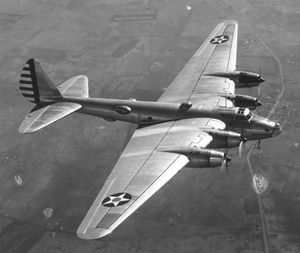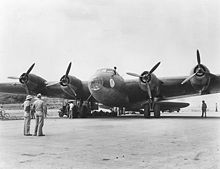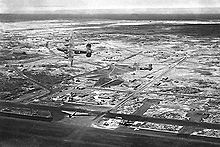Boeing XB-15 Video - Historical pictures and video
|
|
Boeing XB-15
Boeing XB-15

Picture - XB-15 on a test flight
Role: Heavy bomber
Manufacturer: Boeing
First flight: 1937-10-15
Introduced: n/a
Status: Cancelled
Primary user: United States Army Air Corps
Number built: 1 prototype
Developed into: Boeing Y1B-20
The Boeing XB-15 (Boeing 294) was a United States bomber aircraft designed in 1934 as a test for the United States Army Air Corps to see if it would be possible to build a heavy bomber with a 5,000 mile (8,000 km) range. It was originally designated the XBLR-1 (experimental bomber, long range). When it first flew, it was the most massive and most voluminous airplane ever built in the United States. It set a number of load-to-altitude records, including a 31,205-pound flight to 8,200 feet (July 30, 1939).
The aircraft's immense size allowed for passages within the wing, which the crew could use to make minor repairs in flight. Due to the technology of the time, a 5,000 mile flight took thirty-three hours at its 152-mph cruising speed; the crew was made up of several shifts, and bunks allowed them to sleep when off duty.
Development

Picture - The B-15 in Panama.
The XB-15 was designed to be powered by liquid-cooled 1,000 hp (750 kW) engines. Before these were developed, 850 hp (637 kW) radial air-cooled engines were used instead. These engines left the bomber significantly underpowered; its top speed of 200 mph (322 km/h) - 145 mph with bombs on board - was far too slow for a combat aircraft, and the project was abandoned. The single prototype aircraft was assigned to the 2nd Bombardment Group at Langley Field, Virginia. Commanded by Major Caleb V. Haynes, it flew an earthquake relief mission, carrying medical supplies to Chile in February 1939, earning its crew the MacKay Trophy. In 1940 the XB-15 was based in the Panama Canal Zone, taking part in classified bombing tests of canal lock protections. In May a survey flight was made from Panama over the Galapagos islands, with Captain Curtis LeMay as navigator.
Even without the improved defensive armament that would have been needed in service, the XB-15 had a maximum takeoff weight 5,000 pounds greater than the later B-17G, but with a total engine output of 1,800 fewer horsepower. The Army Air Forces converted the only prototype into a transport, designated XC-105, which carried freight around the Caribbean during World War II.

Picture - The B-15 parked on Baltra Island.
In service for eight years, the airplane carried more than 5,200 passengers, 440,000 pounds of cargo and 94,000 pounds of mail. It flew 70 cargo trips and 60 missions including antisubmarine patrol. The XC-105 was scrapped at Howard Air Force Base in Panama in 1945.
Technological achievements

Picture - The XB-15 parked on an airstrip.
Despite its cancellation, the XB-15 did feature a number of significant innovations:
Automatic Pilot
De-icing equipment
Auxiliary power units independent of the main engines to power the electrical system
Engines serviceable in flight using an access tunnel inside the wing
Crew compartment with rest bunks, galley and lavatory
Double-wheel main landing gear.
Operators
United States
United States Army Air Corps
2nd Bombardment Group
Specifications (XB-15)
Data from Boeing Aircraft since 1916
General characteristics
Crew: 10
Length: 87 ft 7 in (26.70 m)
Wingspan: 149 ft 0 in (45.43 m)
Height: 18 ft 1 in (5.51 m)
Wing area: 2,780 ft² (258.4 m²)
Empty weight: 37,709 lb (17,141 kg)
Max takeoff weight: 70,706lb (32,139 kg)
Powerplant: 4x— 14-cylinder Pratt & Whitney R-1830-11 radial engines, 850 hp (634 kW) each
Performance
Maximum speed: 200 mph (174 knots, 322 km/h) at 5,000 ft (1,500 m)
Cruise speed: 152 mph (132 knots, 245 km/h) at 6,000 ft (1,800 m)
Range: 5,130 mi (4,460 nmi, 8,259 km)
Combat radius: 3,400 mi (2,957 nm, 5,474 km)
Service ceiling: 18,900 ft (5,760 m)
Armament
Guns:
3x— .30 in (7.62 mm) machine guns
3x— .50 in (12.7 mm) machine guns
Bombs: 12,000 lb (5,400 kg)
Related development
B-17 Flying Fortress
Boeing Y1B-20
Boeing 314
Comparable aircraft
Martin XB-16
Boeing Y1B-20
Bibliography
Bowers, Peter M. Boeing Aircraft since 1916. London:Putnam, Third edition, 1989. ISBN 0-85177-804-6.
Boeing XB-15 Pictures
Living Warbirds: The best warbirds DVD series.
Source: WikiPedia